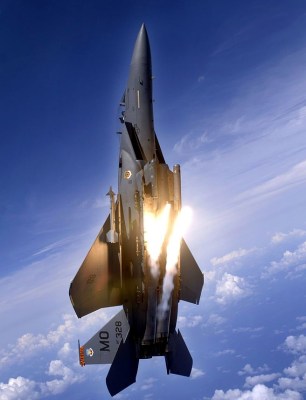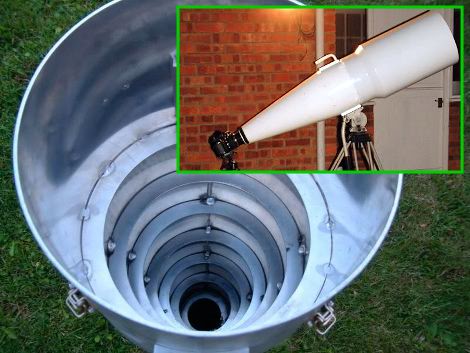Good news, bad news for Sun watchers this week, as our star launched a solar flare even bigger than the one back in May that gave us an amazing display of aurora that dipped down into pretty low latitudes. This was a big one; where the earlier outburst was only an X8.9 class, the one on July 23 was X14. That sure sounds powerful, but to put some numbers to it, the lower end of the X-class exceeds 10-4 W/m2 of soft X-rays. Numbers within the class designate a linear increase in power, so X2 is twice as powerful as X1. That means the recent X14 flare was about five times as powerful as the May flare that put on such a nice show for us. Of course, this all pales in comparison to the strongest flare of all time, a 2003 whopper that pegged the needle on satellite sensors at X17 but was later estimated at X45.
flare7 Articles
Hackaday Links: April 14, 2024
The Great American Eclipse v2.0 has come and gone, sadly without our traveling to the path of totality as planned; family stuff. We did get a report from friends in Texas that it was just as spectacular there as expected, with the bonus of seeing a solar flare off the southwest limb of the disk at totality. Many people reported seeing the same thing, which makes us a bit jealous — OK, a lot jealous. Of course, this presented an opportunity to the “Well, ackchyually” crowd to point out that there were no solar flares or coronal mass ejections at the time, so what people saw wasn’t an exquisitely timed and well-positioned solar flare but rather a well-timed and exquisitely positioned solar prominence. Glad we cleared that up. Either way, people in the path of totality saw the Sun belching out gigatons of plasma while we had to settle for 27% totality.
Hackaday Links: December 24, 2023
Back near the beginning of the current Solar Cycle 25, we penned an article on what the whole deal is with solar cycles, and what could potentially lie in store for us as the eleven-year cycle of sunspot population developed. Although it doesn’t really come across in the article, we remember being somewhat pessimistic about things, thinking that Solar Cycle 25 would be somewhat of a bust in terms of increased solar activity, given that the new cycle was occurring along with other, longer-period cycles that tend to decrease solar output. Well, looks like we couldn’t have gotten that more wrong if we tried, since the Sun lashed out with a class X solar flare last week that really lit things up. The outburst came from a specific sunspot, number 3514, and clocked in at X2.8, the most powerful flare since just before the end of the previous solar cycle. To put that into perspective, X-class flares have a peak X-ray flux of 10-4 watts/m², which when you think about it is a lot of energy. The flare resulted in a strong radio blackout; pretty much everything below 30 MHz was unusable for a while.
Hackaday Links: July 3, 2022
Looks like we might have been a bit premature in our dismissal last week of the Sun’s potential for throwing a temper tantrum, as that’s exactly what happened when a G1 geomagnetic storm hit the planet early last week. To be fair, the storm was very minor — aurora visible down to the latitude of Calgary isn’t terribly unusual — but the odd thing about this storm was that it sort of snuck up on us. Solar scientists first thought it was a coronal mass ejection (CME), possibly related to the “monster sunspot” that had rapidly tripled in size and was being hyped up as some kind of planet killer. But it appears this sneak attack came from another, less-studied phenomenon, a co-rotating interaction region, or CIR. These sound a bit like eddy currents in the solar wind, which can bunch up plasma that can suddenly burst forth from the sun, all without showing the usually telltale sunspots.
Then again, even people who study the Sun for a living don’t always seem to agree on what’s going on up there. Back at the beginning of Solar Cycle 25, NASA and NOAA, the National Oceanic and Atmospheric Administration, were calling for a relatively weak showing during our star’s eleven-year cycle, as recorded by the number of sunspots observed. But another model, developed by heliophysicists at the U.S. National Center for Atmospheric Research, predicted that Solar Cycle 25 could be among the strongest ever recorded. And so far, it looks like the latter group might be right. Where the NASA/NOAA model called for 37 sunspots in May of 2022, for example, the Sun actually threw up 97 — much more in line with what the NCAR model predicted. If the trend holds, the peak of the eleven-year cycle in April of 2025 might see over 200 sunspots a month.
So, good news and bad news from the cryptocurrency world lately. The bad news is that cryptocurrency markets are crashing, with the flagship Bitcoin falling from its high of around $67,000 down to $20,000 or so, and looking like it might fall even further. But the good news is that’s put a bit of a crimp in the demand for NVIDIA graphics cards, as the economics of turning electricity into hashes starts to look a little less attractive. So if you’re trying to upgrade your gaming rig, that means there’ll soon be a glut of GPUs, right? Not so fast, maybe: at least one analyst has a different view, based mainly on the distribution of AMD and NVIDIA GPU chips in the market as well as how much revenue they each draw from crypto rather than from traditional uses of the chips. It’s important mainly for investors, so it doesn’t really matter to you if you’re just looking for a graphics card on the cheap.
Speaking of businesses, things are not looking too good for MakerGear. According to a banner announcement on their website, the supplier of 3D printers, parts, and accessories is scaling back operations, to the point where everything is being sold on an “as-is” basis with no returns. In a long post on “The Future of MakerGear,” founder and CEO Rick Pollack says the problem basically boils down to supply chain and COVID issues — they can’t get the parts they need to make printers. And so the company is looking for a buyer. We find this sad but understandable, and wish Rick and everyone at MakerGear the best of luck as they try to keep the lights on.
And finally, if there’s one thing Elon Musk is good at, it’s keeping his many businesses in the public eye. And so it is this week with SpaceX, which is recruiting Starlink customers to write nasty-grams to the Federal Communications Commission regarding Dish Network’s plan to gobble up a bunch of spectrum in the 12-GHz band for their 5G expansion plans. The 3,000 or so newly minted experts on spectrum allocation wrote to tell FCC commissioners how much Dish sucks, and how much they love and depend on Starlink. It looks like they may have a point — Starlink uses the lowest part of the Ku band (12 GHz – 18 GHz) for data downlinks to user terminals, along with big chunks of about half a dozen other bands. It’ll be interesting to watch this one play out.
Plasma “Ghosts” May Help Keep Future Aircraft Safe
Air-to-air combat or “dogfighting” was once a very personal affair. Pilots of the First and Second World War had to get so close to land a hit with their guns that it wasn’t uncommon for altercations to end in a mid-air collision. But by the 1960s, guided missile technology had advanced to the point that a fighter could lock onto an enemy aircraft and fire before the target even came into visual range. The skill and experience of a pilot was no longer enough to guarantee the outcome of an engagement, and a new arms race was born.

Naturally, the move to guided weapons triggered the development of defensive countermeasures that could confuse them. If the missile is guided by radar, the target aircraft can eject a cloud of metallic strips known as chaff to overwhelm its targeting system. Heat-seeking missiles can be thrown off with a flare that burns hotter than the aircraft’s engine exhaust. Both techniques are simple, reliable, and have remained effective after more than a half-century of guided missile development.
But they aren’t perfect. The biggest problem is that both chaff and flares are a finite resource: once the aircraft has expended its stock, it’s left defenseless. They also only work for a limited amount of time, which makes timing their deployment absolutely critical. Automated dispensers can help ensure that the countermeasures are used as efficiently as possible, but sustained enemy fire could still deplete the aircraft’s defensive systems if given enough time.
In an effort to develop the ultimate in defensive countermeasures, the United States Navy has been working on a system that can project decoy aircraft in mid-air. Referred to as “Ghosts” in the recently published patent, several of these phantom aircraft could be generated for as long as the system has electrical power. History tells us that the proliferation of this technology will inevitably lead to the development of an even more sensitive guided missile, but in the meantime, it could give American aircraft a considerable advantage in any potential air-to-air engagements.
Continue reading “Plasma “Ghosts” May Help Keep Future Aircraft Safe”
Lighting Fires With Lemons
We all know that you can stick copper and zinc in an acid and make a battery. And the classic demonstration of this is with a lemon. YouTuber [NorthSurvival] takes this to an extreme — starting a fire by shorting his lemon battery across some steel wool. (Video embedded below.)
Now calling this a “survival tip” is pushing it. A lot. When’s the last time you went camping with a bunch of zinc and copper nails, much less a supply of fresh lemons? It might be easier to put some matches in a waterproof canister, or just bring a lighter. But when the zombie apocalypse comes, and all the lighters are used up, the man with a lemon tree will be a millionaire.
Seriously, though, this demo made us question a few assumptions. First, when people do the potato- or lemon-battery experiment, they often use multiple lemons. Why? Hooking the pins up like [NorthSurvival] did in series seems like a no-brainer after the fact.
And the lemon seems to be putting out a fair amount of juice (Amperes, that is). We’ve got to wonder — what is the short-circuit current of a lemon battery? And why haven’t we seen specs anywhere? What kind of “science education” experiment is this anyway, without measurements?
You Know That They Say About Guys With Big Lenses?

[Tony Lovell] and [dkpeterborough] built a sizable camera lens using optics from a flight simulator projector. What they ended up with is a 900mm lens that can make a beautiful photo of the moon, or capture distant landscapes in great detail. The body of the lens was designed in CAD and sent off for fabrication out of aluminum, as seen above. The concentric baffles help to prevent lens flare but it can’t be used in its bare-aluminum condition. The internals were coated using a stippling finish that leaves a sandy texture. That was covered with matte black barbecue paint, doing a great job of preventing optical interference, and the outside received a glossy white coat. Finished weight: 59 pounds, but once you see the pictures you’ll agree it’s worth lugging the bulky instrument around to grab that killer shot.
[via Make]














